
Preserving Tomatoes
Whether you have grown more tomatoes in your garden than you can eat fresh from the vine or have purchased a large amount at your local farmers’ market or grocery store, there are many ways to preserve your tomatoes to enjoy later in the year.
For best texture and flavour, store tomatoes at room temperature until preserved.
If you plan to preserve your tomatoes a few days after they are harvested or purchased, there are things you can try to delay ripening. Ethylene is a gas naturally produced by maturing tomatoes and it can be somewhat controlled. Tomatoes can be picked when the blossom end (opposite the stem) starts to turn pink. Also known as the breaker stage, this is when a skin forms between the plant stem and the plant and the tomato receives no additional nutrients from the plant. Ripening may occur either on or off the stem with no loss of flavor.
Tips to Slow Ripening Tomatoes:
- While tomatoes don’t ripen at fridge temps, if they are harvested at the breaker stage, storing them in a cool area no less than about 10 C (fruit cellar, basement or cool garage), will slow down tomato ripening.
- Remove the fruit from the vine when it is at the breaker stage, remove the stems, and wash with cool running water and dry the tomatoes
- Place tomatoes one to two layers deep in a covered box for ripening OR, individually wrap them in brown paper or newsprint and then place in the box. Paper wrapping reduces the buildup of ethylene gas.
Freezing
Wash tomatoes well under cool running water, remove stems, fill freezer bags with whole tomatoes, remove air, label, date and freeze. When the tomatoes thaw, the skins are easy to remove. These can be added to soups and salsa or to make sauce.
Roasting and freezing:
- Use a recipe for exact ingredients, cooking and processing time.
- Roast whole or halved tomatoes in the oven with oil and salt if desired. They can also be roasted on the grill.
- Using a food processor, process roasted tomatoes and season as per recipe. Place into freezer bags, label, date and freeze.
- This can be done with any type or size of tomato.
- Here is an example of a recipe: https://healthyideasplace.com/how-to-roast-tomatoes-for-sauce-and-freezing/but there are many more recipes available.
Removing Seeds and Skins
There are many types of tomato presses, mills and strainer machines that you can purchase to quickly remove the seeds and skin from tomatoes. While these are not necessary, they may save you time if you’d like to make tomato sauce.
- Seeds can be removed manually but cutting tomatoes in half and using a thumb, spoon or scoop to remove the seeds.
- Some people just include the seeds. Either way is fine!
Removing only skin from tomatoes:
- Tomatoes can be scored with an x at the bottom of the tomato with a knife and dropped into boiling water for about 45 seconds, then placed in ice water until cooled. For easy skin removal, use hands or a paring knife to remove the skin.
Drying Tomatoes

- Tomatoes can be dried in the oven, air fryer or in a dehydrator.
- If you have a dehydrator, follow the manufacturer’s instructions.
If you would like to try an air fryer, here is a recipe to try: https://www.allrecipes.com/recipe/285308/air-fryer-sun-dried-tomatoes/
- Drying tomatoes outside in the sun may work, but there are a lot of variables such as insects and changing temperatures that could interfere with the process.
- In the oven, tomatoes are baked at a low temperature for a long period of time, depending on their size until they are shrivelled and dry.
- The can be used right away, frozen or saved in oil for a few days.
- Some recipes to try:
- https://www.gimmesomeoven.com/oven-sun-dried-tomatoes/
- https://www.wholesomeyum.com/how-to-make-sun-dried-tomatoes-in-the-oven/
Canning Tomatoes Safely

Home canning is a wonderful way to preserve tomatoes that are safe to store at room temperature for up to one year. There are many steps to follow for home canning. You need special equipment like glass jars, new metal lids and rings and it is recommended to use a boiling water canner for tomatoes. It’s important to closely follow a recipe that includes current and safe practices for home canning. Botulism is a serious and sometimes fatal illness caused by a common bacteria called clostridium botulinum (C. Botulinum) which grows in moist, oxygen-free environments. Improper home canning can provide ideal conditions for these bacteria to grow and produce dangerous toxins. C. Botulinum is killed by acid in foods. Tomatoes vary in their acidity and overall are considered a borderline high-acid food and need an acid, such as lemon juice or vinegar, to be added for safer canning.
General Steps for Canning Tomatoes:
• Choose ripe fresh tomatoes without cracks or blemishes.
• Wash hands and food preparation surfaces.
• Wash all equipment (glass jars, new metal lids and rings, utensils) in hot soapy water and rinse well with drinkable water.
• Cover jars with water and heat to a simmer (180°F/82°C) in hot water canner.
• Do not put lids and rings in hot water canner.
• Prepare tomatoes as directed by the recipe – always add acid such as lemon juice or vinegar.
• Carefully put tomatoes into jars.
• Place in hot water canner and process according to instructions on the recipe.
Canning recipes for tomatoes:
Crushed Tomatoes
https://www.bernardin.ca/recipes/en/crushed-tomatoes.htm?Lang=EN-US
Italian Style Tomato Sauce
https://www.bernardin.ca/recipes/en/italian-style-tomato-sauce.htm?Lang=EN-US
Seasoned Tomato Sauce
https://www.bernardin.ca/recipes/en/seasoned-tomato-sauce.htm?Lang=EN-US
Whole or Halved Tomatoes
https://www.bernardin.ca/recipes/en/whole-or-halved-tomatoes.htm?Lang=EN-US
References:
Government of Canada (2024) Home Canning Safety
https://www.canada.ca/en/health-canada/services/general-food-safety-tips/home-canning-safety.html
Government of Canada (2024) Safe Food Storage
https://www.canada.ca/en/health-canada/services/general-food-safety-tips/safe-food-storage.html
Penn State Extension (2024) Is This Tomato Ready to Harvest? https://extension.psu.edu/is-this-tomato-ready-to-harvest#:~:text=2.,agent%20produced%20by%20the%20plant.
University of Saskatchewan (2021) All about canning and freezing tomatoes
https://gardening.usask.ca/articles-and-lists/articles-recipes/canning-and-freezing-tomatoes.php






About The Author: Ginette Blake
Ginette learned to garden from her parents while growing up in Sudbury where the growing season is quite short. She has never tasted better raspberries than the ones they snacked on all day long every July! Ginette joined the London Middlesex Master Gardeners in 2018 and completed the course requirements in horticulture at the University of Guelph. She became a Master Gardener in 2020. Ginette spends her professional life and a lot of her personal life celebrating and working with wholesome foods. She has a degree in Applied Human Nutrition from the University of Guelph and has been a Registered Dietitian for 29 years working in the area of health promotion, food literacy, and food insecurity.
More posts by Ginette Blake